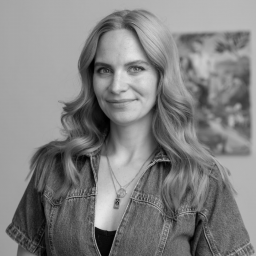Art Fairs
Frieze London’s Director: There Are ‘Reasons for Optimism’ Ahead of This Year’s Fair
Eva Langret on climate initiatives, supporting young galleries, and what to expect in Regent's Park.
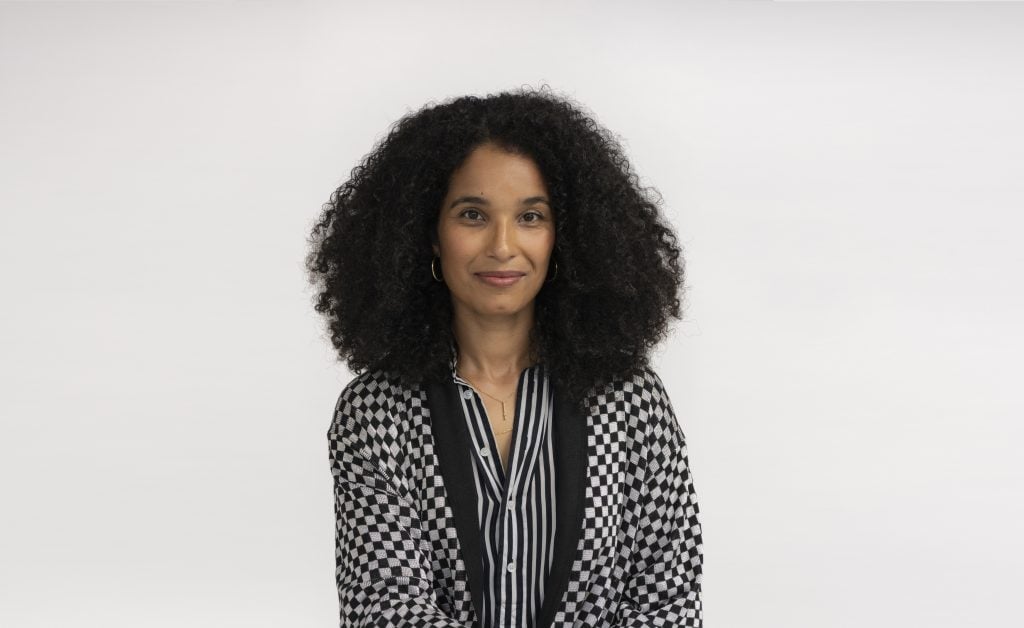
Large white tents are being raised in Regent’s Park, which can only mean one thing: Frieze Week is here.
Frieze London’s director, Eva Langret, has been overseeing what she calls a “facelift” for the fair, which will have a new entrance and layout designed by the local firm A Studio Between that aims to enhance the visibility of its curated sections.
Now in its 21st year, the fair opens to VIPs on October 9 and runs through October 13, with 165 galleries from 43 countries. (Concurrently, across the park at Frieze Masters, 130 galleries from over two dozen countries will be participating.) Visitors will be greeted by two solo presentations—one by Danielle Dean, from the New York gallery 47 Canal, the other by Bani Abidi, from the Kolkata gallery Experimenter. They are part of the “global energy” theme of this year’s fair, which is inspired by London’s cultural melting pot, Langret said.
Even in these post-Brexit times, Langret sees London as a stage for international talent. “It’s a city where young artists, curators, and writers converge from all over the world to discover themselves, find their communities, and write their stories,” she said. She moved from France to London in 2005, and said that she feels “deeply indebted” to the U.K. capital, which felt more “global, open, and diverse” than her native Paris when she was growing up.
With the recent boom in Paris’s contemporary gallery scene, there has been a lot of speculation as to whether London can maintain its place as the foremost European trade center within the art industry, especially given the administrative woes that Brexit begat. With the introduction of Art Basel Paris, which opens its third edition just days after Frieze closes, many have wondered whether the London fair may lose some business opportunities. But, for Langret, Frieze is more than just a commercial platform: it has a role to play in supporting artists and the city’s art and culture ecosystem.
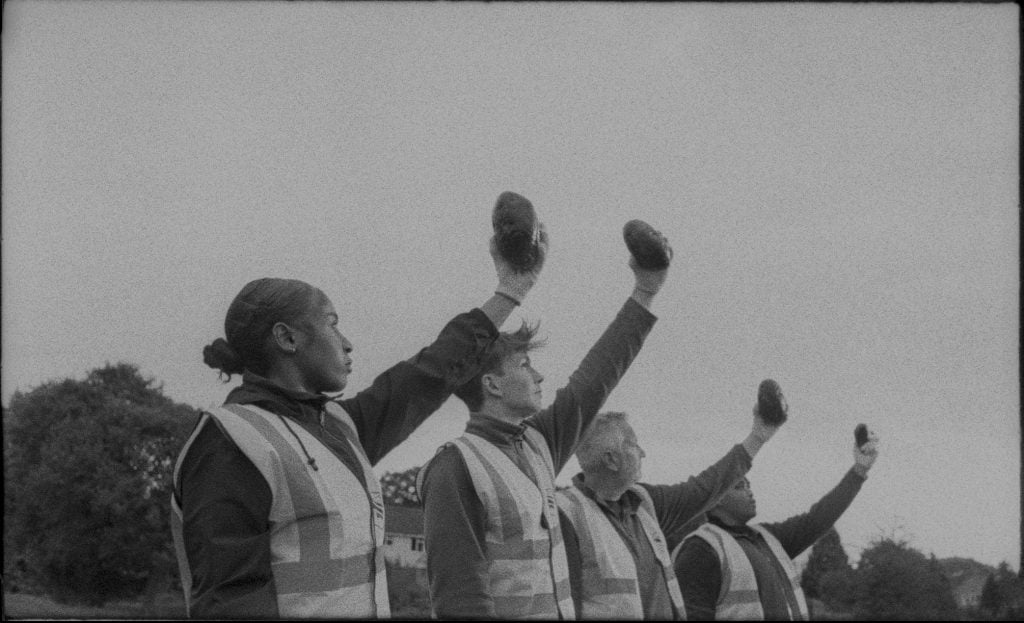
Danielle Dean, production still from Hemel (2024). Courtesy the artist and 47 Canal, New York.
“When I first visited Frieze [in 2005], I remember being struck by the sheer breadth of everything that was on offer, to see galleries from all over the world, but also the talks, the artists’ commissions, the projects, the performances, and the restaurants,” she said. “All of this makes for such a rich experience, and has always been what really sets Frieze London apart from the other fairs.”
Last year, in an effort to emphasize its artist-centered mission, the fair launched a program called Artist-to-Artist, which asks well-known artists to tap young peers for solo presentations at the fair. This year’s lineup includes Appau Jnr Boakye-Yiadom, chosen by Glenn Ligon; Rob Davis, by Rashid Johnson; Nengi Omuku, by Yinka Shonibare; Massinissa Selmani, by Zineb Sedira; Magda Stawarska, by Lubaina Himid, and Peter Uka, by Hurvin Anderson.
I caught up with Langret as she prepared for the fair, which included exercising “a lot,” she said. “It helps me manage the pressure and maintain the stamina needed for the long days and nights of Frieze Week.” We discussed how the fair is evolving in response to both economic and social pressures, whether London’s art market is really in peril, and what to look out for on the fair floor.
Frieze London rounded an important milestone last year with its 20th anniversary. How has this shaped your plans going forward? In what ways has the fair “matured” from a scrappy alternative art fair into a world-renowned event? Is that identity shift difficult, or how do you deal with it?
Frieze has always been a trailblazing force in the art world, starting with its beginnings as a magazine and continuing to the launch of the fair, all the way through to the debut of Frieze Seoul in 2022. The art world has grown and changed significantly over the last 20 years and, while the fair may have matured, we aim to keep that same spirit and artist-centered approach in everything we do. Another clear reflection of this evolution is the global reach of Frieze London. Last year, we welcomed visitors from 92 countries, highlighting the fair’s international character.
Our focus now is on harnessing that maturity to continue innovating. We’re introducing changes this year that highlight the young talent for which Frieze London is known, while offering a more seamless experience for collectors and visitors alike. This balance between evolution and staying grounded in our founding principles is what allows Frieze to remain at the forefront.
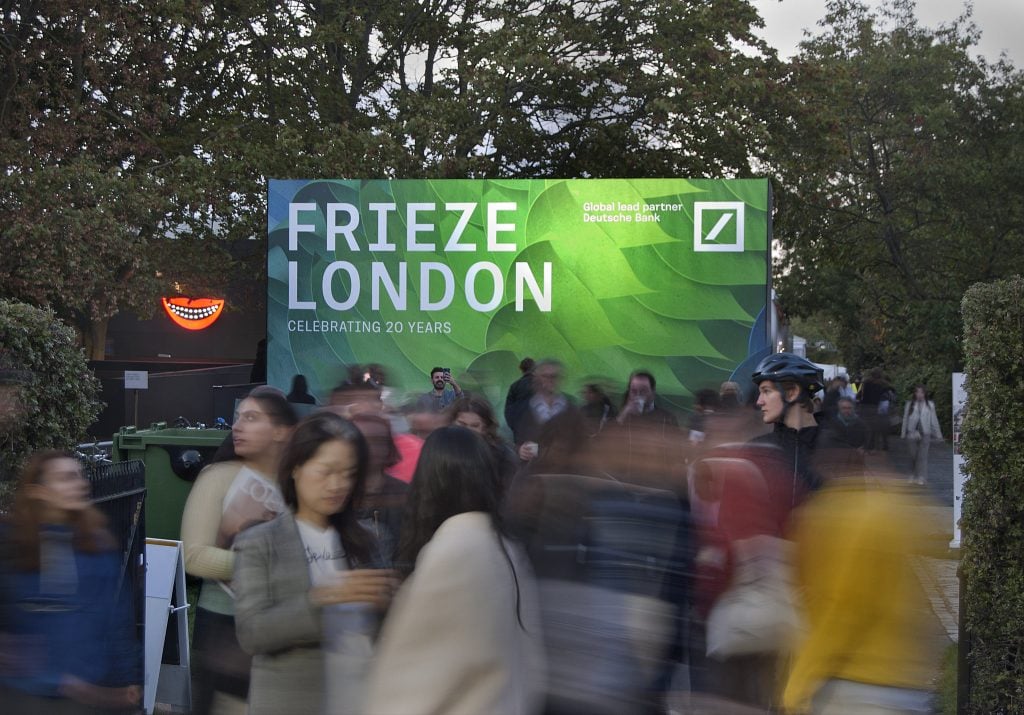
Frieze London 2023. Photo: Lyndon Douglas. Courtesy Frieze / Lyndon Douglas Photography.
There is a lot of pressure on the fair model right now, from exhibitor costs to carbon footprint. Do you see the fair model changing going forward and, if so, how?
We are always evolving our fair model to meet the changing needs of our community. In terms of more practical ways of looking after our galleries we always actively seek to reduce costs for exhibitors and share best practices with all participating galleries so they can all make the most of their Frieze experience. For example, last year, we introduced a global partnership with the fashion brand Stone Island, which provides bursaries that cover up to 30 percent of the stand fee for each Focus gallery. Combined with Frieze’s existing subsidies of the section, it offers significant support to emerging galleries to better enable their participation in the fair.
Similarly, we see sustainability as essential to the future of art fairs—an opportunity rather than a challenge. Like many industries, the art world must adapt, and Frieze is committed to helping to drive this forward. We have contributed to the development of the recently launched Galleries Climate Coalition toolkit, which is designed to help art fairs adopt sustainable practices. As public awareness of environmental issues grows, galleries and collectors are increasingly attracted to organizations that actively reduce their ecological impact. By staying adaptable, we ensure art fairs remain both relevant and responsible.
The market has been in a tough spot as of late. How does that shift some of your priorities when planning the event or how you work with galleries and artists?
While this year has seen a more cautious approach from both collectors and galleries, solid sales reported at fairs in September, including Frieze Seoul and the Armory Show, have given the market a few reasons for optimism as we head into October. Moreover, despite the chatter, the strength of the U.K. market remains high—it’s the third-largest art market in the world and worth more than the rest of Europe combined. Plus, there is the international appeal of London, which provides a valuable launch pad for artists and galleries.
This year we are introducing a major redesign, part of which is a reorientation of the fair’s floor plan to enhance visibility for younger galleries, aligning with our founding principles of supporting the entire art ecosystem. By giving emerging voices a prominent platform, we’re continuing our commitment to the future of contemporary art. While major galleries and established artists will always play a key role, this emphasis on new talent provides a more holistic experience for collectors. It offers them the opportunity to discover the next wave of influential artists. Even in more cautious markets, collectors are excited by the prospect of fresh, innovative works that have potential.
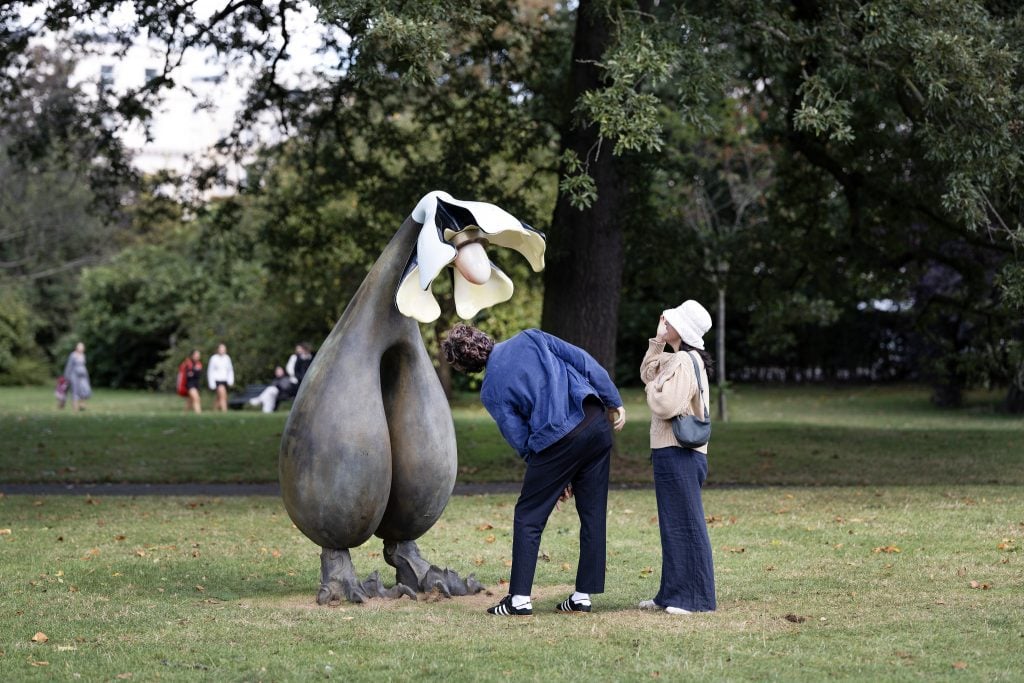
Park-goers take in Theresa Chromati’s steadfast, step into me (allow silence to create the sounds you desire most) (2022), part of Frieze Sculpture 2024. VETA by Fer Francés. Photo by Linda Nylind. Courtesy of Linda Nylind/ Frieze.
The redesign also includes the addition of large windows in the tent that allow passersby in Regent’s Park to see in more. What was the thought process behind adding a bit more transparency to the layout?
Regent’s Park is such an unusual and special setting for an art fair—far from the convention centers where one typically expects a fair to take place. It felt natural to highlight this in the new design, creating opportunities to open up sight lines and allow views of the park from inside the tent as well as art from outside.
The U.K. hasn’t been getting great press lately, with high interest rates, ongoing strain from Brexit, and a new Labour government that has made no bones about how broke it is. In what ways has this shaped the fair this year, if any?
We remain deeply committed to supporting London’s creative ecosystem, which continues to be a place of innovation. The creative industries contribute over 12 percent to the capital’s economy and provide employment for one in five people—more than a million jobs in the city. Recognizing and supporting its importance is crucial, especially as the sector is set to expand. The mayor’s office predicts that by 2030, an additional 1.2 million workers will be needed to meet the industry’s growing demands.
We’ve rolled out several initiatives designed to uplift and strengthen the arts sector. Our partnerships with funds such as the Frieze Tate Fund and the Arts Council Collection Fund play a crucial role in ensuring that important new works are brought into the public sphere, enriching the U.K.’s cultural offerings. Through our partnership with Deutsche Bank, we also support emerging Black and POC curators with 12-month, paid fellowships at leading U.K. institutions. Ben Swaby Selig, our 2022 curatorial fellow, will present a research-based activation at the fair after his placement at V&A East. Another highlight is the Camden Art Centre Emerging Artist Prize, which offers an opportunity for an artist to present their first solo exhibition at the Camden Art Centre in 2025. Last year’s winner, Jack O’Brien, will debut a major new commission during Frieze Week—a moment we’re incredibly excited about.
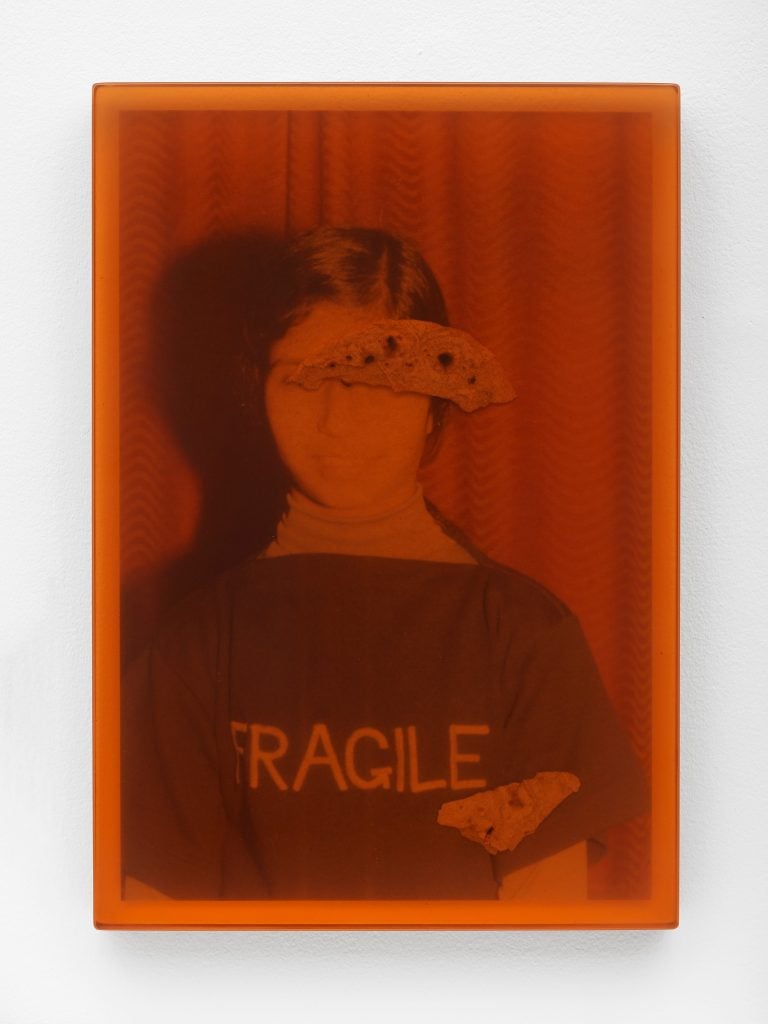
Jasleen Kaur, Untitled (2024). © Jasleen Kaur. Courtesy the artist and Hollybush Gardens, London. Photo: Andy Keate.
Where are you seeing opportunities for change or hope?
There are a lot of young galleries in the city. This year, we’re thrilled to welcome a number of London-based first-time exhibitors—a true testament to our currency as a creative capital. I think the continued opening of new galleries reflects London’s potential and resilience. Emerging galleries like Xxijra Hii, presenting a solo exhibition by Hannah Morgan, exemplify the dynamic, forward-looking spirit that defines the city.
What are your top three must-sees at the fair this year?
It’s almost impossible to choose! One I’m really excited about is 47 Canal’s showcase of works by Danielle Dean, featuring a new series of watercolors inspired by her experience growing up as one of the few Black children in 1980s Hemel Hempstead. Another highlight is Lisson’s presentation of Japanese-Swiss artist Leiko Ikemura; it’ll be the gallery’s first time exhibiting her work since they announced representation earlier in the year. Hollybush Gardens’ group presentation is also a must-see, featuring new works by 2024 Turner Prize nominees Claudette Johnson and Jasleen Kaur.

